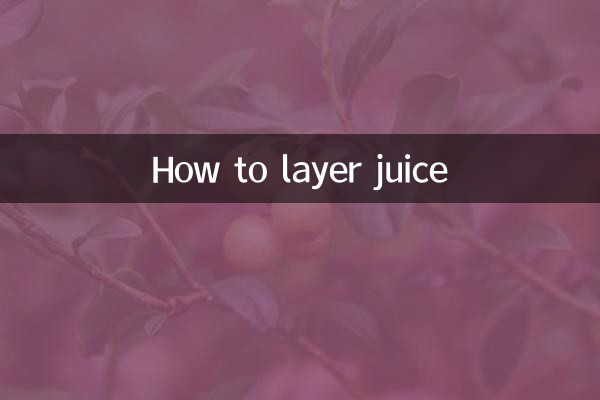How to Layer Fruit Juice: Scientific Principles and Fun Experiments
Recently, interesting experiments on "juice layering" have become a hot topic on social media, with many netizens sharing their own rainbow juices or layered drinks. This article will combine scientific principles and practical steps to analyze how to achieve juice stratification through density differences, and attach the hot topic data from the entire network in the past 10 days for reference.
1. Basic principles of juice stratification

The key to fruit juice layering isDensity difference. Different juices or liquids have different densities due to different sugar content and ingredients. By adjusting the ratio or adding a thickener, the liquids can be made immiscible and form a stable stratification effect.
| liquid type | Density(g/cm³) | Recommended layering order |
|---|---|---|
| Pomegranate juice (added sugar) | 1.05-1.10 | Ground floor |
| mango juice | 1.03-1.05 | middle level |
| coconut milk | 1.02-1.04 | Upper middle class |
| Lemonade (sugar-free) | 0.99-1.01 | top level |
2. Hot topic data on the entire network in the past 10 days
Here are some of the hot topics recently discussed related to “juice layering”:
| platform | hot topics | Number of discussions (10,000) |
|---|---|---|
| Douyin | #rainbowjuicechallenge | 42.3 |
| #The science of layered drinks | 18.7 | |
| little red book | DIY Layered Drink Tutorial at Home | 15.2 |
| Station B | Density layering experiment video | 9.8 |
3. Detailed explanation of practical steps
1.Material preparation: Choose 3-4 juices with obvious color differences (such as purple grape juice, orange juice, coconut milk), and ensure the density gradient.
2.Density adjustment: Density can be increased by adding syrup or honey, or reduced by diluting with water.
3.Layering techniques: Use a long-handled spoon to slowly pour the liquid along the wall of the cup, leaving 30 seconds between each layer to stabilize.
4.Things to note: Avoid shaking the cup and keep the temperature consistent (the effect is better after refrigeration).
4. Frequently Asked Questions
Q: Why do my layers mix?
A: It may be due to insufficient density difference or too fast pouring speed. It is recommended to use a sugar meter to measure and adjust.
Q: Which juices are not suitable for layering?
A: Juice containing pulp particles (such as papaya juice) is easy to damage the layers and needs to be filtered before use.
5. Scientific expansion and application
This principle can also be used in cocktail making, children's science experiments and other scenarios. Recently a university chemistry department demonstrated in a short video"Seven-story density tower"Experiments (using syrup, dish soap, etc.), the number of views exceeded 5 million within 7 days.
By mastering the scientific principle of differences in liquid density, you can not only create visually stunning layered juices, but also spark an interest in physical chemistry. Come and try to create your own rainbow cup with different juices!

check the details

check the details